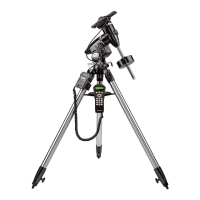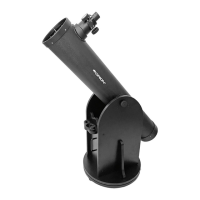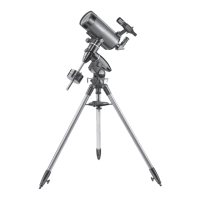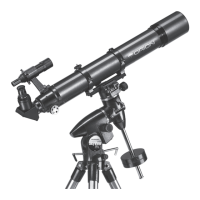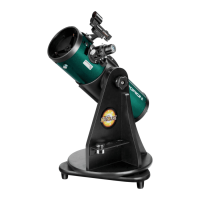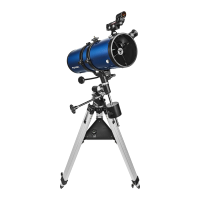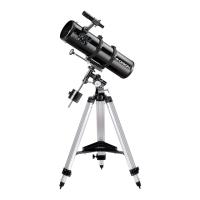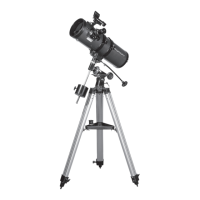7
Tighten the nut with the provided 14mm crescent wrench
(S) while holding the bolt stationary with the 6mm hex
key (P).
9. On each of the base’s side panels, install a plastic spring
post (H) as shown (Figure 7). Thread the Philips-head
screw (G) into the threaded metal insert in the hole and
tighten. Make sure the thick part of the post is closest to
the side panel, as shown.
10. Next, insert one of the long screws with a rosette knob
attached through the end ring of one of the springs (J).
Slip a spring post onto the screw. Orient the spring post
so the narrow end is closest to the knob (I). Thread
the entire assembly into the hole in the center of the
telescope’s altitude side bearing until tight (Figure 8).
The end ring of the spring should seat onto the narrow
end of the spacer. Repeat this procedure for the other
altitude side bearing.
11. Now lift the optical tube (X) and set the altitude bearings
on either side of the tube in the “cradles” of the side
panels (Figure 9).
12. Attach a pull loop (O) to the free end of each spring. To
do this, rst feed the loop through the end ring (Figure
10A), then insert the opposite end of the pull loop
through the loop (10B). Finally, pull it taught; it should
look like Figure 10C.
Figure 12. Slide the red dot scope’s bracket into the
dovetail base, then secure it with the thumbscrew.
Figure 11. Remove the adhesive backing from the bumper
pad and place it on the inside of the front brace where the
bottom end of the optical tube makes contact. The bumper
will cushion such contact when the telescope is in use.
Figure 13. The 2" Crayford focuser of the SkyQuest XT
Classic Dobsonian is shown with the 1.25" eyepiece installed.
Front of
telescope
Eyepiece
Focusing knobs
Focus lock
thumbscrew
1.25" adapter
2" collar
Figure 14. The SkyQuest XT Classic has two axes of
motion: altitude (up/ down) and azimuth (left/right).
Azimuth
Altitude
Bumper
